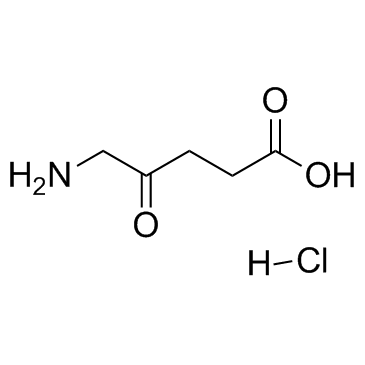5-Aminolevulinic acid hydrochloride

5-Aminolevulinic acid hydrochloride structure
|
Common Name | 5-Aminolevulinic acid hydrochloride | ||
|---|---|---|---|---|
| CAS Number | 5451-09-2 | Molecular Weight | 167.59 | |
| Density | 1.2±0.1 g/cm3 | Boiling Point | 311.5±27.0 °C at 760 mmHg | |
| Molecular Formula | C5H10ClNO3 | Melting Point | ~150 °C (dec.) | |
| MSDS | Chinese USA | Flash Point | 142.2±23.7 °C | |
| Symbol |

GHS07 |
Signal Word | Warning | |
|
Identification and Characterization of EDTA Test Strip Interfering Substances Using a Digital Color Detector.
Clin. Lab. 61 , 785-91, (2015) Rapid test strips for ethylenediaminetetraacetic acid (EDTA) can be used to verify correct specimen types for clinical assays which require, or cannot be performed on, plasma collection tubes containing EDTA anticoagulant. As the test strip reaction chemistry... |
|
|
N-3 fatty acids improve body composition and insulin sensitivity during energy restriction in the rat.
Prostaglandins Leukot. Essent. Fatty Acids 91(5) , 203-11, (2014) The hypothesis that n-3 polyunsaturated fatty acids (PUFA) could contribute to maintain muscle mass during energy restriction aiming to weight loss was tested in the rat, with special attention paid to insulin signalling. After 10 weeks on a diet rich in lipi... |
|
|
Determination of free fatty acids in human serum by HPLC with fluorescence detection.
J. Chromatogr. Sci. 53 , 537-41, (2015) It has been suggested that serum concentrations of polyunsaturated essential fatty acids correlate with the symptoms or severity of various diseases, including depression and Alzheimer-type dementia, and that determination of serum fatty acids might be import... |
|
|
The Escherichia coli small protein MntS and exporter MntP optimize the intracellular concentration of manganese.
PLoS Genet. 11(3) , e1004977, (2015) Escherichia coli does not routinely import manganese, but it will do so when iron is unavailable, so that manganese can substitute for iron as an enzyme cofactor. When intracellular manganese levels are low, the cell induces the MntH manganese importer plus M... |
|
|
Antioxidant effect of erdosteine and lipoic acid in ovarian ischemia-reperfusion injury.
Eur. J. Obstet. Gynecol. Reprod. Biol. 183 , 23-7, (2014) To investigate the effects of erdosteine and alpha lipoic acid (ALA) in a rat model of ovarian ischaemia-reperfusion injury.Forty-eight female Wistar albino rats were separated, at random, into six groups of eight rats. The groups were classified as: sham, to... |
|
|
Safe lipid nanocapsule-based gel technology to target lymph nodes and combat mediastinal metastases from an orthotopic non-small-cell lung cancer model in SCID-CB17 mice.
Nanomedicine: Nanotechnology, Biology, and Medicine 11 , 1237-45, (2015) The purpose of this study is the assessment of gel technology based on a lauroyl derivative of gemcitabine encapsulated in lipid nanocapsules delivered subcutaneously or intravenously after dilution to (i) target lymph nodes, (ii) induce less systemic toxicit... |
|
|
Oscillating glucose and constant high glucose induce endoglin expression in endothelial cells: the role of oxidative stress.
Acta Diabetol. 52 , 505-12, (2015) High glucose-induced oxidative stress has been suggested as one of the mediators of endothelial damage in diabetes. The major endothelial protein, endoglin, has been found overexpressed in the vessels during pathological situations, but little is known about ... |
|
|
Omega-3 Polyunsaturated Fatty Acids Trigger Cell Cycle Arrest and Induce Apoptosis in Human Neuroblastoma LA-N-1 Cells.
Nutrients 7 , 6956-73, (2015) Omega-3 (n-3) fatty acids are dietary long-chain fatty acids with an array of health benefits. Previous research has demonstrated the growth-inhibitory effect of n-3 fatty acids on different cancer cell lines in vitro, yet their anti-tumor effects and underly... |
|
|
Proinflammatory effects of arachidonic acid in a lipopolysaccharide-induced inflammatory microenvironment in 3T3-L1 adipocytes in vitro.
Appl. Physiol. Nutr. Metab. 40(2) , 142-54, (2015) Long-chain n-3 polyunsaturated fatty acids (PUFA), eicosapentaenoic acid (20:5n-3, EPA) and docosahexaenoic acid (22:6n-3, DHA), have known anti-inflammatory effects, including the modulation of adipose tissue-derived inflammatory mediators (i.e., adipokines)... |
|
|
Omega-3 free fatty acids inhibit tamoxifen-induced cell apoptosis.
Biochem. Biophys. Res. Commun. 459(2) , 294-9, (2015) Fish oil, which contains omega-3 fatty acids mainly in the form of triglycerides, has benefits for reducing breast cancer risk, similar to tamoxifen action. However, it remains to be elucidated whether the combination of omega-3 free fatty acid (ω-3FFA) with ... |